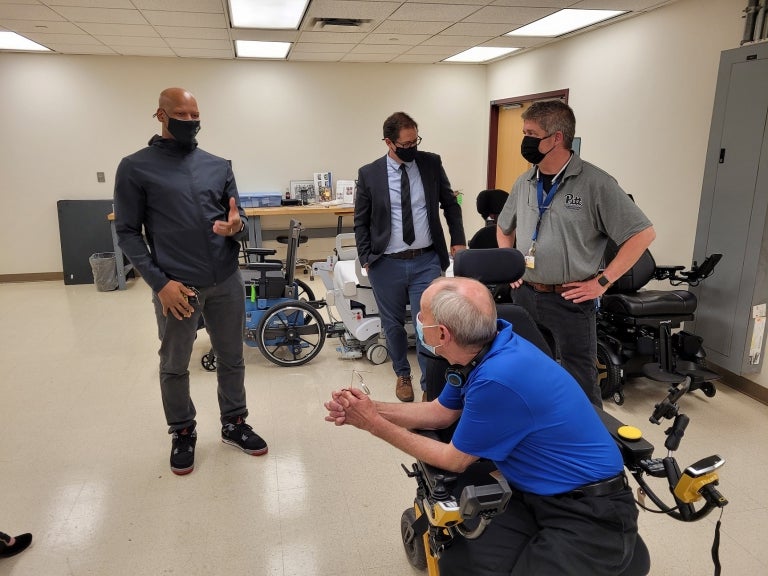
Former Pittsburgh Steelers linebacker Ryan Shazier is now building a different type of team to tackle his new target: The barriers that people with spinal cord injuries face. And he’s working with the University of Pittsburgh School of Health and Rehabilitation Sciences Center for Assistive Technology (CAT) to do it!
On Wednesday, June 2, Shazier visited the CAT in Oakland for a tour, joined by Caroline Boyce and Maya Haptas of the Ryan Shazier Fund for Spinal Rehabilitation. Rehabilitation Science and Technology Department Chair Jon Pearlman and Vice Chair for Education and Training Mark Schmeler were excited to welcome them.
“This was a very productive initial discussion. Mr. Shazier had an opportunity to see first-hand many of the assistive technology opportunities for people with disabilities,” said Schmeler. “We share a very common theme that people with spinal cord injury need better access and encouragement to regain full participation in their communities. He also obviously values engagement in adaptive sports and recreation as an important component of inclusion.”
Shazier personally knows the importance of rehabilitation and assistive technology. In December 2017, a devastating injury on the field left him wondering if he would ever be able to walk again. Thanks to the dedicated help of therapists and other health care professionals and a lot of time in a wheelchair, he is back on his feet again and ready to pay it forward.
The Shazier Fund was established in 2020 with the mission to “ensure all spinal cord injury patients have the same support and fighting chance as Ryan to live independent and meaningful lives, no matter their socioeconomic status.”
To accomplish this mission, he is partnering with local organizations to build strong networks that are helping people recover from and live with spinal cord injuries and other disabilities.
“After our tour at the Center for Assistive Technology, I was so inspired by all the work that was happening to support individuals with spinal cord injuries live independent and meaningful lives," said Shazier. "We are so lucky to have resources like the CAT right here in Pittsburgh.”
Maya Haptas, program coordinator for the Shazier Fund, is excited to move the chains.
“This was a really informative tour, and now that we have an in-depth understanding of what they do [at SHRS], we are better positioned to work together towards our mutual goals of supporting individuals with spinal cord injuries,” explained Haptas. “The CAT is such a great resource we can share with the individuals we work with. We look forward to working with CAT to bridge this gap and magnify our impact.”
The two-hour tour of the facilities gave Shazier and his team a chance to see some of the newest inventions and innovations being developed, including the many types of wheelchairs available, voice recognition programs, and communication devices, among others, and how assistive technology can help reduce health disparities and improve equity, justice and inclusion. But the tour is just the first play in what promises to be a long and fruitful partnership.
“We are fortunate to have Ryan and his team at the Shazier Foundation in the Pittsburgh area,” said Pearlman. “And we look forward to collaborating with them and supporting their mission to improve the lives of individuals with spinal cord injury.”
